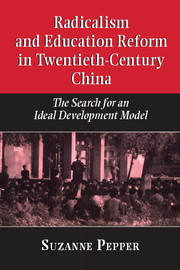Book contents
- Frontmatter
- Contents
- Acknowledgments
- 1 Educational development and the Chinese experience
- Part I The republican era: origins of radical education reform
- Part II Learning from the Soviet Union
- Part III Cultural revolution and radical education reform
- 11 On Stalin, Khrushchev, and the origins of cultural revolution
- 12 The great leap in education
- 13 A system divided: walking on two legs into the 1960s
- 14 Education reform as the catalyst for cultural revolution and class struggle: the 1966–1968 mobilization phase
- 15 Education reform as the culmination of class struggle: the professional educator's perspective
- 16 Education reform as the culmination of class struggle: the critical ideals triumphant at last
- 17 The Cultural Revolution negated
- 18 The mixed triumph of regularity
- 19 Chinese radicalism and education development
- Appendix: the Hong Kong interviews
- Select bibliography
- Index
16 - Education reform as the culmination of class struggle: the critical ideals triumphant at last
Published online by Cambridge University Press: 04 August 2010
- Frontmatter
- Contents
- Acknowledgments
- 1 Educational development and the Chinese experience
- Part I The republican era: origins of radical education reform
- Part II Learning from the Soviet Union
- Part III Cultural revolution and radical education reform
- 11 On Stalin, Khrushchev, and the origins of cultural revolution
- 12 The great leap in education
- 13 A system divided: walking on two legs into the 1960s
- 14 Education reform as the catalyst for cultural revolution and class struggle: the 1966–1968 mobilization phase
- 15 Education reform as the culmination of class struggle: the professional educator's perspective
- 16 Education reform as the culmination of class struggle: the critical ideals triumphant at last
- 17 The Cultural Revolution negated
- 18 The mixed triumph of regularity
- 19 Chinese radicalism and education development
- Appendix: the Hong Kong interviews
- Select bibliography
- Index
Summary
Ultimately, the “professional educator” and the “radical reformer” emerged as ideal types more than real people. Such individuals undoubtedly existed somewhere. But the reality as described by interviewees suggests that the best way of illustrating the endemic ambivalence they had inherited was to let everyone assume their place along a hypothetical spectrum where most would have fallen between the two extremes while combining varying elements of both. Had the reform package appeared in some less radical version, then, it probably could have mustered a much larger constituency of support.
Many approved the shortened 10-year curriculum at the elementary and secondary levels, for example. Resentment was expressed over labor, politics, and practical learning in unplanned excess but never per se. Sentiment against the pretensions of key-point schools was widespread. Their elitist hierarchical form may have had ancient roots, but its deliberate extension nationwide within a fast-growing modern school system dated only from 1958.
The associated practices of cramming and pushing up pass rates could also boast ancient pedigrees – as could the body of critical literature deploring them. Teachers generally still accepted the 1950s arguments from Soviet pedagogy on the drawbacks of streaming students by ability, an obvious contradiction with the principle of key-point development that many acknowledged and pondered.
Yet, had the reform package been advanced in less radical terms, its most widely acknowledged success – quantitative growth – could not have been achieved to the same degree.
- Type
- Chapter
- Information
- Radicalism and Education Reform in 20th-Century ChinaThe Search for an Ideal Development Model, pp. 414 - 465Publisher: Cambridge University PressPrint publication year: 1996



